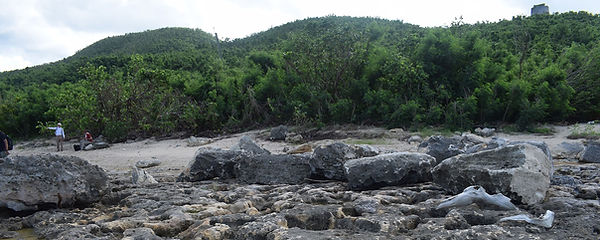top of page

Coastal Boulder Deposits and associated features can only be created or rearranged when coastal land is inundated by high velocity water. Inundation can either break off new boulders from bedrock or coral reefs, or move existing CBD to new locations. Inundation leading to CBD almost always comes from one of two sources: tsunamis, or storm waves and surge.
Major tsunamis are rare events where one or more large, long period, waves inundate coastal areas. Tsunamis usually arise from the motion of the seabed during offshore earthquakes, but can also be generated by landslides or meteor impacts. During strong tsunamis, high velocity water can inundate to more than 1km inland. These high velocities are known to move large boulders, generating records of inundation that can last for hundreds to thousands of years.
Many examples of tsunami boulders are known around active seismic zones, and they can be transported long distances. Some boulders are remnants of prehistoric or unrecorded events, and provide long-lasting markers that can be used to infer seismic history. Others were created or transported during recorded events, and may be correlated with the known strength of the earthquake or tsunami.

Coral tsunami boulders on a fringing reef flat, Amami-Oshima, Japan
Waves and surge can also inundate land during storms. Inundation may be either from tropical hurricanes, typhoons or cyclones (which are really the same thing but have different names in different places), or from non-tropical (usually winter) storms. Some boulders may be at low elevation on horizontal shore platforms or reefs. These may be transported hundreds of meters inland, possibly over long time scales during multiple storms.

Shore platform boulders on St. Croix after Hurricane Maria
Boulders for both storms and tsunamis may be transported on top of high coastal cliffs, where the storm or tsunami runup inundates the clifftops. Boulders here are usually carved out of the rock near the cliff edge, and pushed inland. These boulders are not usually transported far when compared to lower elevations, and when inundation is repeated, long linear ridges may form. If inundation occurs more infrequently, individual boulders or small clusters may be found.

Obi Rock, Shimoji Island, Miyakojima, Japan. This was transported by the 1771 Meiwa tsunami
Credit: Paipateroma, via Wikimedia Commons

Clifftop boulder after Typhoon Haiyan, Calicoan Island, Philippines
Some boulders have indeterminate origins, and may have been generated and transported by tsunamis, storm waves, or possibly even a combination of the two. In these cases, the source is important because the boulder gives evidence of either tsunami or storm wave inundation, and planning and preparation may be different for each.
These indeterminate boulders can be the source of fierce debates on their origins, and it is hoped that collaboration and data sharing made possible by ISROC may help to shed some light on the subject.
bottom of page


